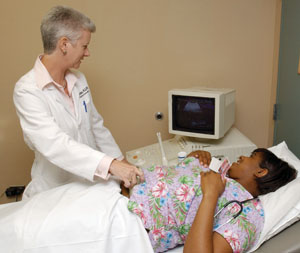
Katherine Hartmann, M.D., Ph.D., here examining patient Aberita Chapple, is studying the treatment of uterine fibroids. (photo by Susan Urmy)
Study calls for more uterine fibroid research
Uterine fibroids affect most American women over 50, but there is surprisingly little evidence to help compare standard treatment recommendations, according to a report released last week by researchers at the RTI International-University of North Carolina at Chapel Hill Evidence-based Practice Center.
The lead clinical author of the report was Katherine Hartmann, M.D., Ph.D., deputy director of the Institute for Medicine and Public Health at Vanderbilt University Medical Center and vice chair for Research in the Department of Obstetrics and Gynecology.
Hartmann began the evidence review while at UNC, and completed it after she arrived at Vanderbilt.
Uterine fibroids are non-cancerous growths of the uterus that cause symptoms in about half of the women who have them.
Concerns may include heavy bleeding, pelvic pain, backaches, bowel and bladder function changes, and painful intercourse.
They affect more than 80 percent of African-American women and nearly 70 percent of white women in the United States by age 50.
Historically, the solution for decades has been “dear, you need a hysterectomy,” Hartmann said.
“The body of knowledge from the literature is strikingly limited. Considering that millions of women in the U.S. have fibroids, there has been completely inadequate research attention and funding focus on high quality research in this area.”
The systematic evidence review updated the 2001 Agency for Healthcare Research and Quality's systematic review on the management of uterine fibroids. The research examined 107 research studies conducted on the topic between 2000 and 2006.
Current treatment for uterine fibroids varies in terms of invasiveness and cost. The report says that there has been woefully little research comparing the risks and benefits of different treatment options, and few pharmaceutical options for symptom relief have been studied for long-term effectiveness.
The report did show that women who received a uterine artery embolization, a newer non-surgical treatment that shrinks the fibroid, had shorter hospital stays and a quicker recovery than those who received a hysterectomy or myomectomy, which removes the fibroids without removing the uterus.
But few studies compared complications, long-term symptom relief or looked at the choice of either treatment with other treatments.
There was also little evidence of long-term symptom improvement with MRI-guided ultrasound ablation of fibroids, another new treatment that uses high intensity, focused ultrasound waves to destroy the fibroid tissue.
“We've come another seven years with a lot of research done on the topic, but it's still not the quality of research you would want,” Hartmann said.
“The fact is, these are common, and we don't know how to tell patients whether they'd be better off choosing a uterine artery embolization or a myomectomy because the head-to-head comparison studies with appropriate lengths of follow-up are just now being done.”
Another area of concern, and an area of focus in the report, is women with fibroids who are considering becoming pregnant, especially those who have had a miscarriage or who are having trouble with infertility.
These women get fairly pointed advice from their gynecologists that they should consider surgery, Hartmann said.
“But in this review, we're saying that there's just not enough evidence to make that suggestion except in one instance — women with fibroids that are jutting into or in contact with the uterine cavity,” she said.
“How did we get to the point where 20-50 percent of women in their reproductive age are going to have fibroids and we have no medical management strategies, we have very limited direct comparison of surgical intervention, and we can't even advise women what they ought to do about their reproductive function with respect to fibroids, with the exception of about 10-20 percent of women who have fibroids in the uterine cavity?” Hartmann asked.
“So 80 percent of young women of reproductive age with fibroids are in the dark about whether or not they should intervene, and we're flying by the seat of our pants trying to give them advice.”
Hartmann said another message from the report is that women with fibroids should make sure they understand their surgeon's experience level, inquiring about complication rates and how many procedures the surgeon has done.
“The surgeon should be very frank with the patient about her risk of transfusion, of having a hysterectomy, of having complications, and of what the recovery period looks like,” she said.
“This information is available in the literature and should be a key component of informed consent. These procedures are not risk free.”













